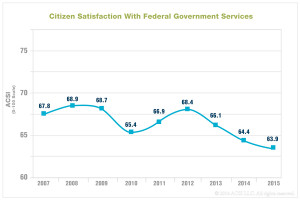

A new report on customer service details gap between agencies' and citizens' perceptions, and challenges to improvement.

Federal agencies need better data and communications to understand who their customers are and what they want. That’s the takeaway from a report published on Feb. 23 by the Partnership for Public Service and Accenture, a professional services consulting company. The report highlights four key areas in which agencies fall short when engaging with citizens.
The report cited the 2015 American Customer Satisfaction Index, which found citizen satisfaction has continued to decline for three straight years. In 2015, the federal government received an ACSI score of 63.9 out of 100 — the lowest score in nine years.
The report, entitled Government for the People, examined 12 agencies that have a high level of direct contact with citizens through a series of interviews with agency leaders, experts and employees. Researchers asked federal executives to self-assess the customer service experiences their organizations provide, and the results were out of sync with customer perceptions.
“There was a little bit of a gap between the perception agencies had, that gave themselves an average grade of about a ‘B,’ and the perception that the public has in terms of the quality that they receive from the government,” said Kathy Conrad, director of digital government at Accenture and a former General Services Administration executive in the Office of Citizen Services and Integrated Technologies, during an interview on Federal Drive with Tom Temin. “So I think the priority is to try to narrow that gap by addressing these four challenges.”

The report found the government overall needs to improve its practices in gathering and using customer data. What agencies are currently receiving isn’t providing a clear or complete picture of customer satisfaction, the report stated.
“While the annual surveys are valuable, they’re not sufficient,” Conrad said.
The report called for agencies to gather feedback from customers continuously, immediately after interactions.
“Those data should be timely and they should include the voice of the customer feedback,” she said.
The data also frequently isn’t representative of customer perceptions. Chief Veterans Experience Officer Tom Allin at the Veterans Affairs Department highlighted this discrepancy, “We’ve been asking the questions we think must be important. We haven’t asked our veterans what’s important to them.”
Agencies also don’t share data efficiently enough, either internally or externally, the report stated. Employees at field offices frequently cannot access information on customers’ online interactions, for example. Agencies also face numerous challenges to sharing data among departments, including privacy concerns and a lack of standardization in data-gathering practices.
The report identified governance as the second primary concern. The Partnership and Accenture said “five of the 12 agencies lacked a detailed, up-to-date customer experience plan or strategy. And nine did not have a senior leader explicitly responsible for improving the customer experience across the organization.”
The report called for more clarity and consistency among the agencies. A specific and consistent strategy could help reduce confusion and misunderstandings among employees.
“Every employee in an agency should feel accountable for delivering their mission and serving their customers,” Conrad said. “At the same time, what many agencies have done is that they have many different organizations and executives who are responsible for different parts of the customer experience, but no single organization or executive with visibility and accountability for all of the interactions that affect the customer and their experience with that agency or with a particular service.”
The third concern the report addressed is communication with the customers. It recommended involving customers more directly in the planning and designing of services in order to better accommodate them, and using less complicated terminology and jargon in these services.
Another way agencies can improve communication is to use newer methods. Customers can address agencies more quickly and directly via social media, and the report cited instances that imply customers are likely to be more candid when using these tools.
The final area of concern is workforce management. The report suggested agencies need to do better at attracting and screening job applicants for customer service experience, and providing current employees with the proper training and tools to identify customers and their needs.
Copyright © 2025 Federal News Network. All rights reserved. This website is not intended for users located within the European Economic Area.
Daisy Thornton is Federal News Network’s digital managing editor. In addition to her editing responsibilities, she covers federal management, workforce and technology issues. She is also the commentary editor; email her your letters to the editor and pitches for contributed bylines.
Follow @dthorntonWFED

